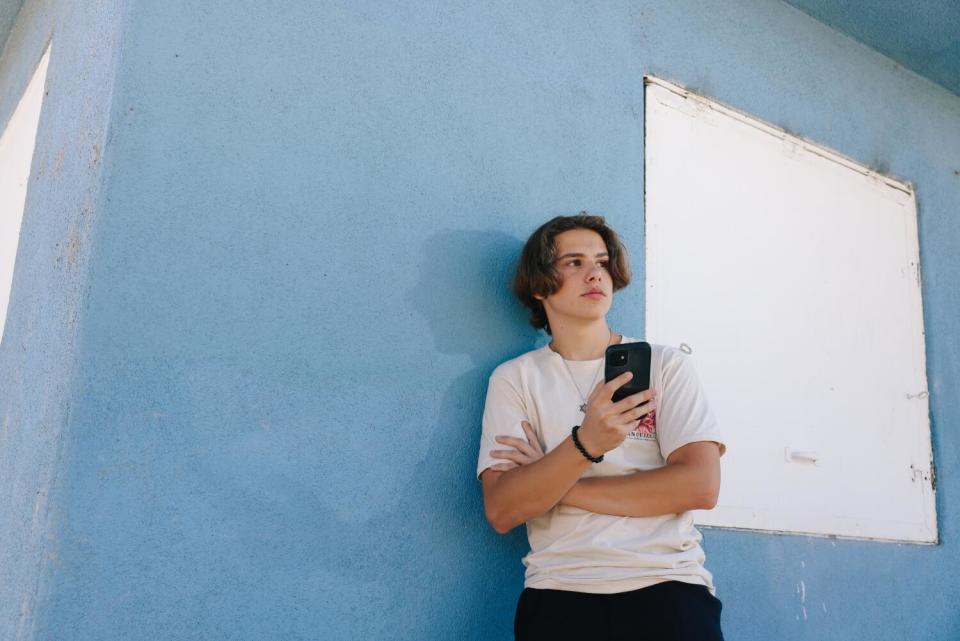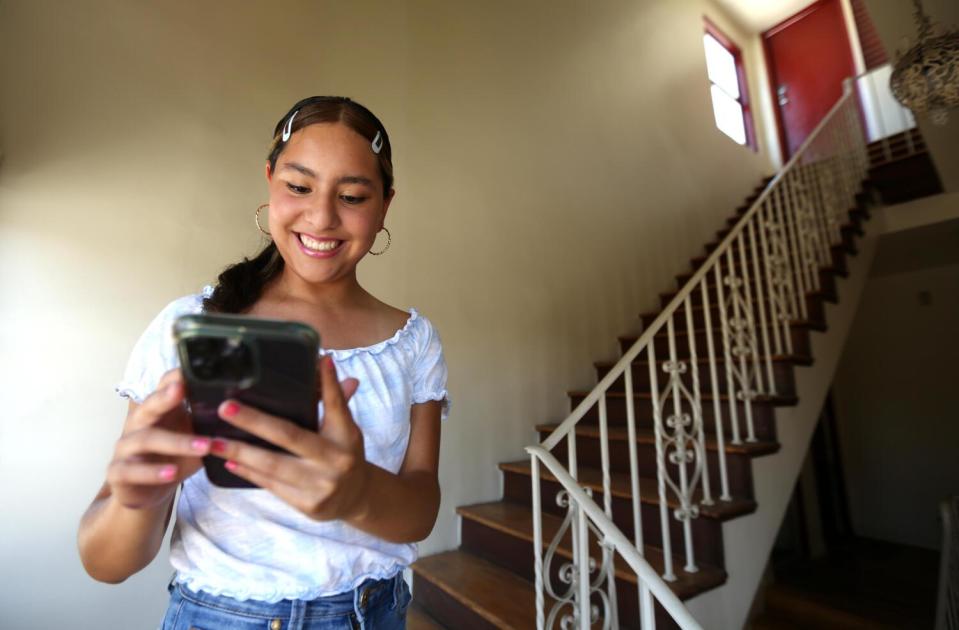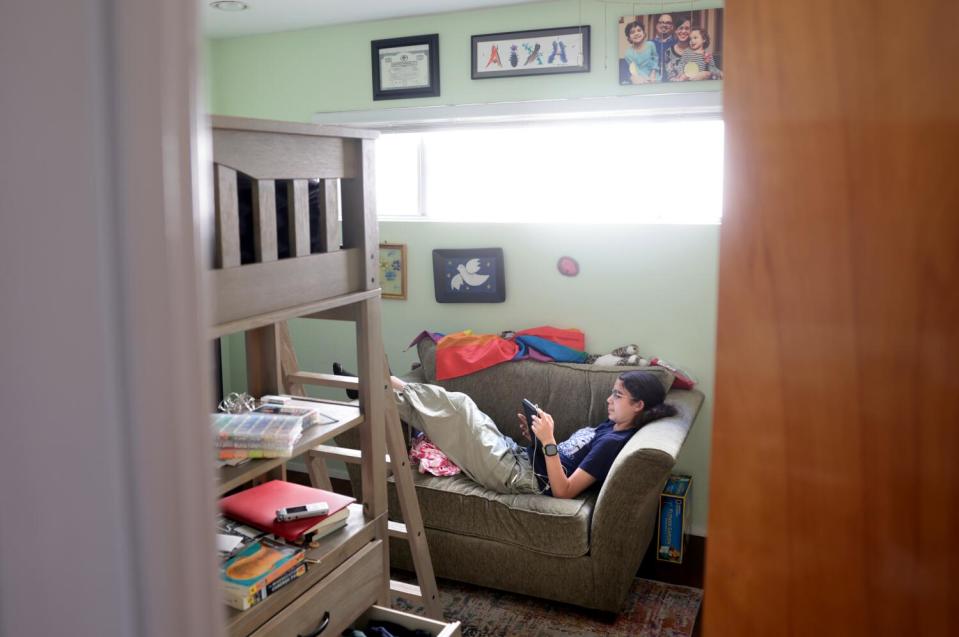Since William Schnider got his first iPhone in sixth grade, it’s become an extension of his being. By day, it’s in his right pants pocket; by night, it’s within arm’s reach. He rarely talks to people on his phone, instead communicating through Instagram groups, TikTok memes, and text messages. He syncs his calendar with his parents’ phones.
When William, a 17-year-old senior at Van Nuys High School, heard that cell phones would be banned in all public schools in Los Angeles, he immediately laughed, like so many others.
“I don’t see how it’s going to work,” he said. “I don’t see how it’s fair. Is this necessary?”
But after the initial shock and an absolute “no” from many teenage students, more nuanced thoughts emerge: Maybe we are falling into an addiction to social media and cell phones. Maybe all the distractions and obsession with “likes” are bad for us. Maybe we need some relief.

The board of education’s 5-2 vote to ban cellphones starting in January 2025 is intended to change the behavior of a generation of students and will be one of the most sweeping and closely watched changes to education since students were forced to attend school online, often over the phone, more than four years ago at the start of the pandemic.
Details, such as how the rule will be enforced and where phones will be stored during the school day, will be hammered out in the coming months. But the goals are clear. School leaders say they want to combat classroom distractions that hinder learning and reduce the dangers of social media addiction. For now, leaders say, a strict ban on phones is the only way to get students to talk to each other and their teachers, and to value face-to-face conversations over digital connections.
Read more: LAUSD approves cellphone ban as Newsom calls for statewide action
“I understand the intent of the ban,” said Schnider, who is in a medical career program and wants to become a physical therapist or physician assistant. “I definitely think phones can be addictive or distracting. It can be very easy to hyperanalyze what you’re putting on social media. People — me — fall into that trap very easily. They start basing their self-worth on how many likes they get on their stories, how many comments their friends make, things that aren’t as important.”
He finds himself scrolling endlessly through Instagram or repeatedly checking to see how many people have liked a story he recently posted about him and a friend watching “Inside Out 2” together. He’s seen students reach for their phones in class when math class gets tough.
He also enjoyed finishing his assignments early in English and then playing the word game Connections with friends — without the teacher objecting. Students with good grades like his, he said, don’t need a phone ban. When two students were stabbed on campus in November and the school went into lockdown, William texted his mother to tell her he was safe. He wonders how emergencies will work without that option.
“For people with problems, this is not going to stop any addiction,” Schnider said. “If you want to be addicted to your phone, you will be.”
Los Angeles will join a growing movement in K-12 education to ban phones, and has won the support of Gov. Gavin Newsom, who has sponsored a bill to implement such a rule statewide. Last year, Florida passed a policy banning cell phones in all K-12 classrooms. A similar law is set to go into effect in Indiana next year. In Ohio, new legislation will require schools to develop policies to “minimize” cell phone use by students. New York City, the nation’s largest school district, is poised to implement a ban on cell phones for students this month similar to Los Angeles’s, after lifting a previous ban in 2015.
For Angélica Zamora-Reyes, 17, a senior at Downtown Magnets High School, the ban can’t come soon enough. She was one of dozens of L.A. students interviewed by The Times — and she expressed relief.
When her parents gave her an iPhone as a birthday present three years ago, Angélica was excited because she was one of the last in her group of friends to get one. Over time, she began to see the pros and cons of digital devices.


When Angélica took the public bus to an internship this summer, she texted her parents along the way to let them know she was safe. She has an Instagram account to keep in touch with friends and watches YouTube videos, including campus tours and vlogs from students at USC and Harvard, her dream colleges. She also watches online math video tutorials on Khan Academy.
Angélica, who lives near historic Filipinotown and is the daughter of Mexican immigrants, discovered new ways to learn and expand her world beyond her own neighborhood of Los Angeles through her phone.
But she also saw the pitfalls of cellphones. Girls at her school can be “obsessed” with social media, comparing their clothes, weight and followers to those of other teens, she said. She recently looked at her screen time monitor — 2.5 hours on a late Thursday afternoon in June — and felt a sense of accomplishment as she compared herself to a cousin whose daily usage was several times that.
Angélica tries to keep her phone in her backpack side pocket during the school day. But even when she avoids using it, she gets distracted by other students on their phones.
She recalls an incident last year when a teacher in her Advanced Placement class was giving instructions for an assignment, but she could barely hear over the loud, persistent laughter of two classmates who were engrossed in their phones.
“Not only was it distracting, but it felt disrespectful to the teacher and other students,” Angélica said. She remembers wishing all classes were like AP English, where her teacher banned cell phone use during class.
In the last semester of her senior year, her wish will come true.
Read more: Too much screen time is hurting kids, experts agree. So why are parents ignoring them?
But when she thinks about it, she has questions. Could she pick up her phone to take pictures of friends at lunch, like she often did last school year? Could she still use her phone occasionally in class to take pictures of the whiteboard instead of taking notes?
Under the approved ban, the answer is no. However, L.A. school officials said students will be included in the regulations and enforcement policy that will go before the school board in the fall.
“While it would be good if phones were banned, I also see the benefits,” said Angélica.
When another student at her school, Noreen Baig, first heard about the ban – through an Instagram message her mother sent from her mobile phone – she thought it was a hoax.
“A widespread ban is not okay,” the 11th-grader said. Some of her classes already ban phones.
She also worries about emergencies. Her school had multiple lockdowns last year, and each time she texted her mother to see how things were going.
“Do we all have to run from one classroom to the office to make a phone call?” Baig said. She also uses social media to find out when and where school clubs are meeting. At lunch, she finds her friends in the cafeteria through Instagram posts.
“My phone is a part of me,” Baig said. “LAUSD is trying to solve a small problem by taking technology away from everyone.”
For many students, the reality of a cell phone ban is difficult to grasp.
But that’s not the case for A Quindel Peral, an eighth-grader at Mark Twain Middle School.
Her mother, an algebra and data science teacher at Venice High School, was part of a team of teachers who launched a schoolwide phone-free program in March. A wears a Gabb watch to school, a simpler version of an Apple Watch designed to have limited functions — including GPS and texting — so parents can stay in touch with their children. At home, A has access to a Wi-Fi-enabled iPad, which she uses to text friends and play chess and Wordle.


She is one of two people in her group of high school friends who does not have a phone. At first, A felt left out, even angry. Her parents say she will get a phone when she starts high school, and by then the school day ban will be in effect.
But when she went to school without her phone, A noticed that she behaved differently than other students. She was able to focus better and longer on assignments and reading. She noticed that some of her classmates would hide their phones behind books during class, pretending to read when they were actually texting and scrolling. With her mother’s encouragement, she started learning more about teens and technology.
“Children are in their critical growth phase right now, basically. They’re at a time in their lives where their brains are growing tremendously. They’re more susceptible to peer pressure,” she said. “It’s really important that we don’t abuse the power that phones give us. It really depends on how you use them.”
Still, she looks forward to having a cell phone when the time comes, but she doesn’t count down to it as much as she used to.
Sign up for Essential California and receive news, features and recommendations from the LA Times and other sources in your inbox six days a week.
This story originally appeared in the Los Angeles Times.